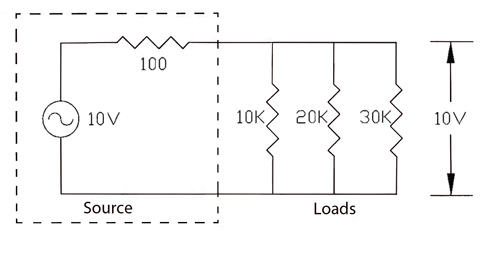A common task in Audio Land is the need to feed a number of inputs from a single signal source. This may include driving a rack of amplifiers, providing feeds to the press, or distributing a signal around a building or campus.
The methods used to accomplish this range from the profoundly simple to quite complex, and the appropriate method must be determined after sizing up the situation.
Impedance matching means that an output is terminated with a “mirror” input impedance (Z). This configuration yields maximum power transfer, and more importantly reduces reflections of the signal voltage from a load back to the source.
In multimedia systems, the matched interface is used for high frequency signals. These include video, antenna and digital interfaces. One drawback of the matched interface is that active or passive splitters must be used if the source must drive multiple inputs.
In a constant voltage interface, an electronic signal source (an output) is expected to develop a signal voltage across a high impedance (an input). The minimum ratio between the source Z and load Z is one order of magnitude (1:10).
This scheme is used universally in the audio industry for passing signals from component to component. One utility of this interface is that it provides the possibility of driving multiple parallel loads from a single source without additional hardware.
The stipulations are:
1. The parallel combination of all loads cannot violate the 1:10 minimum impedance ratio.
2. The path length (interconnecting cable) must be short when compared to the wavelength of the highest frequency component of the signal.
Since the speed of propagation of electricity approaches the speed of light, and audio cables are typically less than a few hundred feet, the second condition is easily met in the vast majority of audio applications.
Radio frequency, digital, and video signal wavelengths are much shorter, and the impedance matched interface must be used in lieu of the constant voltage interface to prevent signal degradation.

“Y” To The Rescue
Figure 1 shows an equivalent circuit of a single source driving multiple loads. Note that even though the input impedances are not the same, this is a parallel circuit, so all of the inputs have the same voltage impressed across them.
In this example, signal distribution requires a simple “Y” cable connected from the source to the multiple loads. Alternately, the loads can be “daisy chained.” Power amplifiers often provide parallel inputs to facilitate this.
A drawback to Y-cable signal distribution is the lack of isolation between the individual loads and the source.















